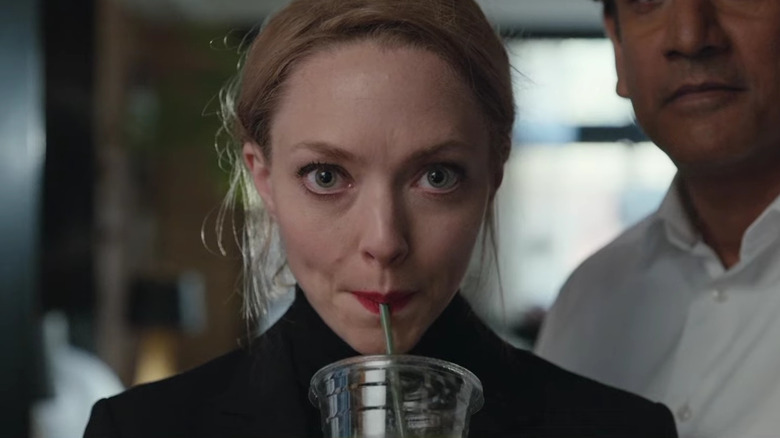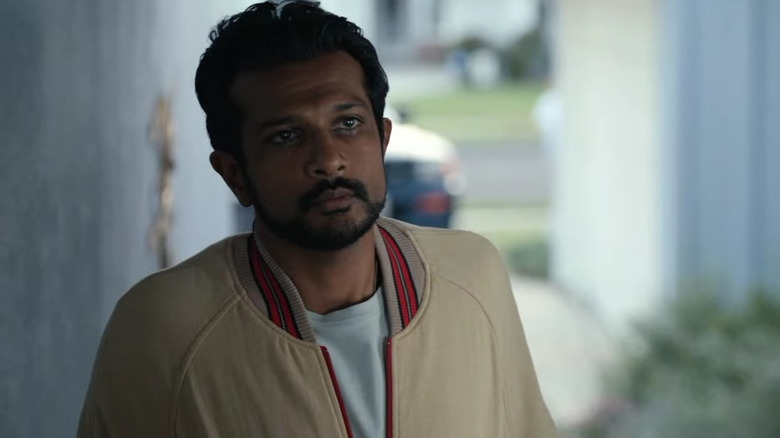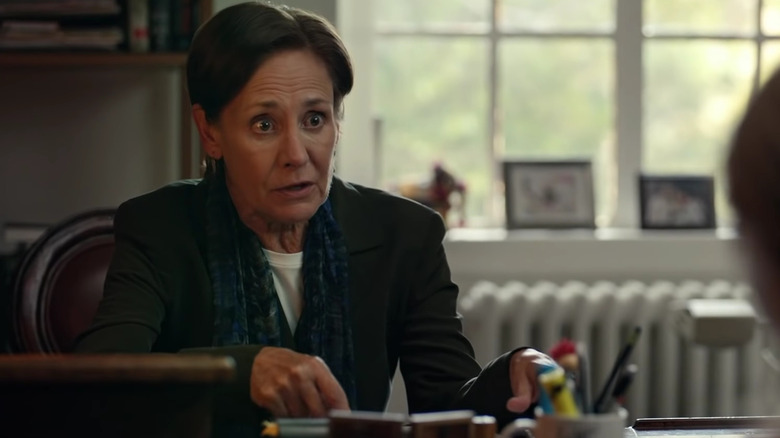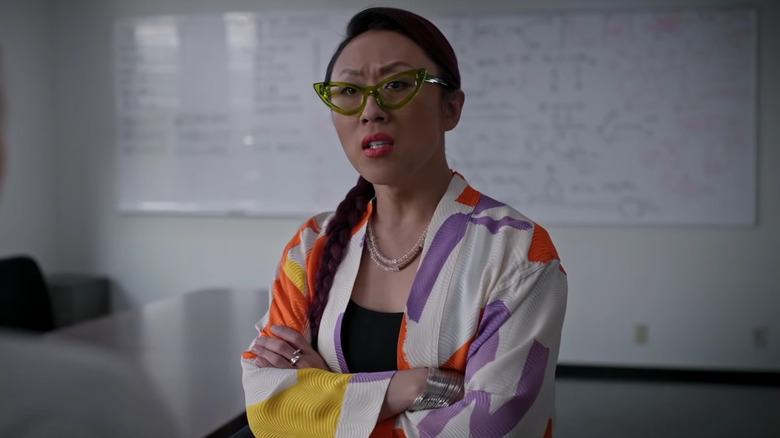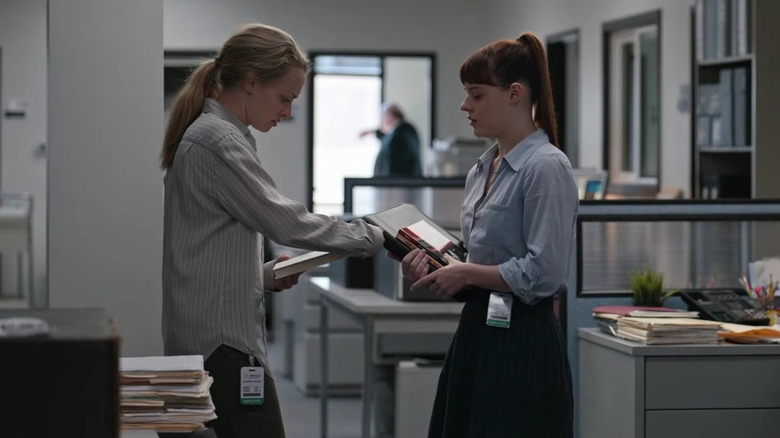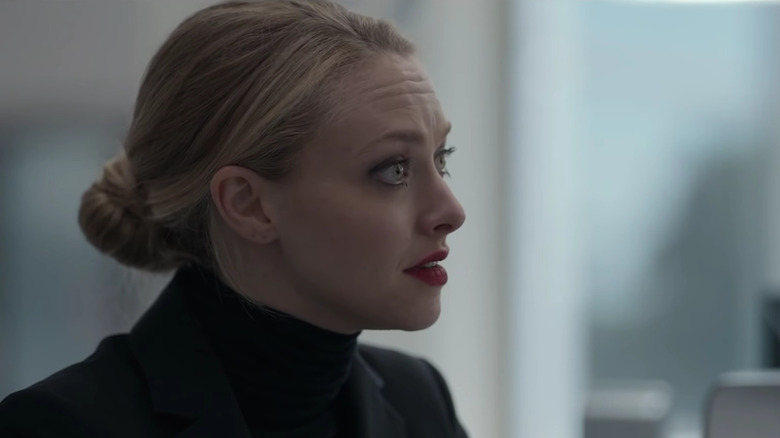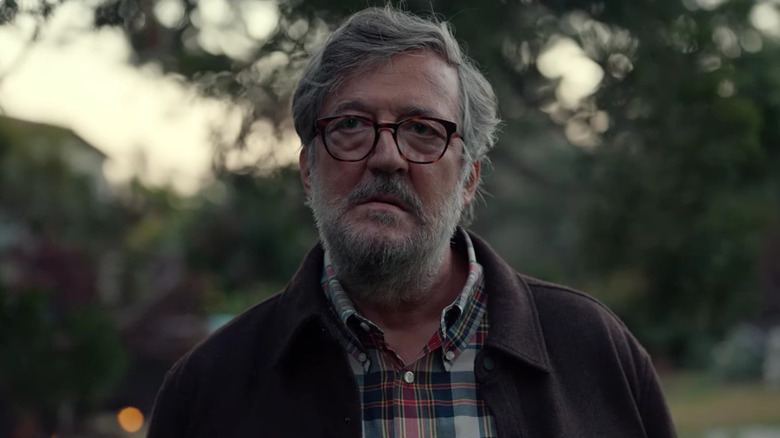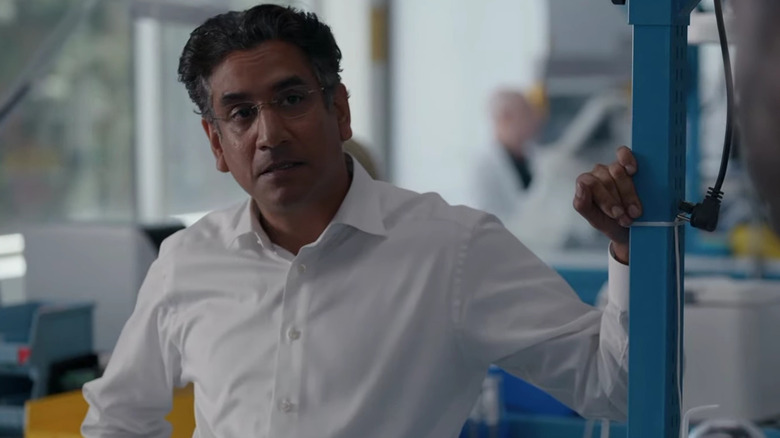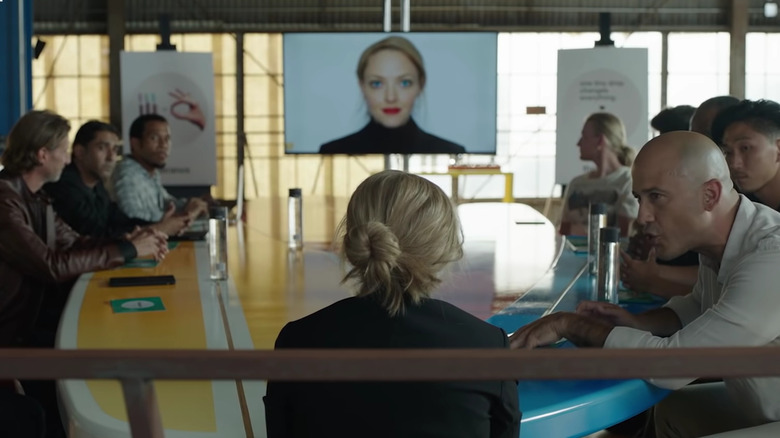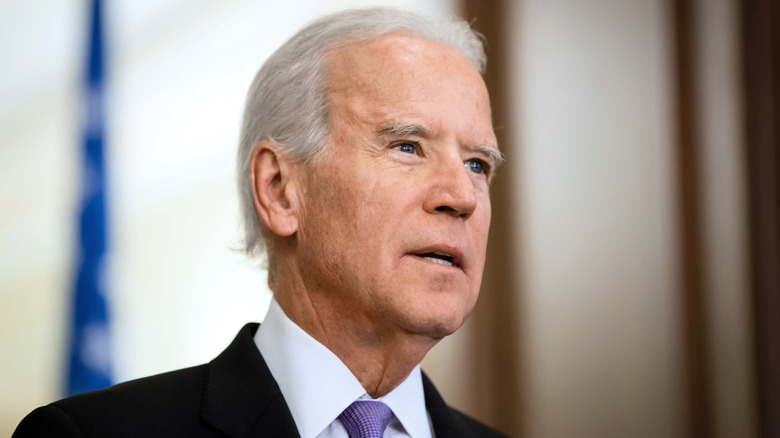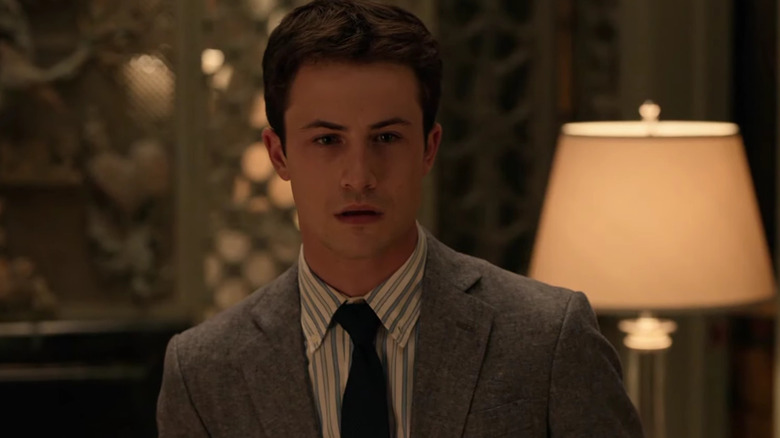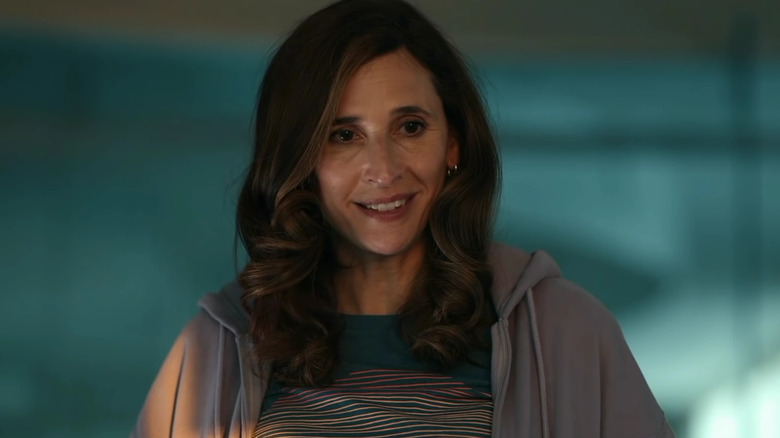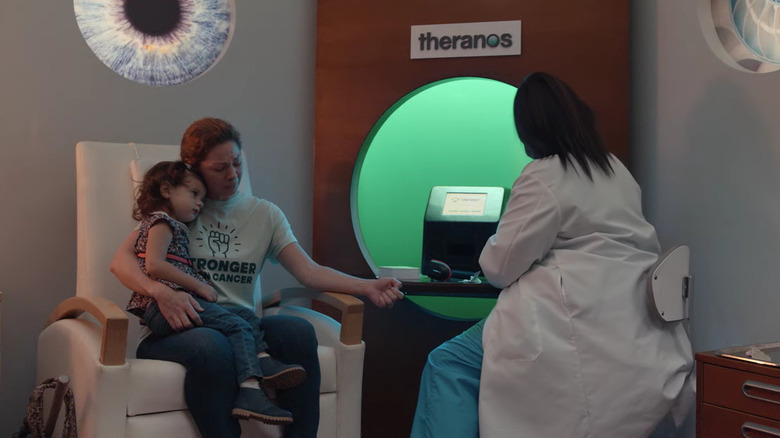Everything The Dropout Got Wrong About The True Story
After being exposed by a handful of whistleblowers and reporter John Carreyrou of the Wall Street Journal, Elizabeth Holmes and her company Theranos became hot topics in the news. The company claimed to have created technology that would change healthcare with just a few drops of blood, but that was very different from the unsettling practices that were actually taking place in their labs. Perhaps the most interesting part about this whole situation was how Holmes managed to build her $9 billion company and get away with it for over a decade.
Holmes' fascinating story has been covered in great detail by ABC News' podcast "The Dropout," which served as the foundation for Hulu's drama series of the same name. While the Hulu version of "The Dropout" did an excellent job of sticking to the facts, certain aspects of Holmes' story were either altered or omitted in the TV series. Here's everything "The Dropout" got wrong about the true story.
A few fictional characters
Many of the key players in Theranos' rise and fall were featured in the Hulu series as characters of the same name. Interestingly, there were a few exceptions to this, including Rakesh Madhava and Brendan Morris, who were both Theranos employees in the show but not in real life, according to Parade.
In the show, Rakesh Madhava was one of Holmes' first allies. He started out as Holmes' TA who gave her connections to Stanford professor Channing Robertson and became one of Theranos' first engineers. As it turned out, Madhava's character shared many similarities with real-life Theranos employee Shaunak Roy, who's credited as Theranos' cofounder in John Carreyrou's book "BAD BLOOD: Secrets and Lies in a Silicon Valley Startup" (via KQED). The book mentions how Roy met Holmes at Stanford and played a role in faking a product demo in Switzerland. Both of those details align with Rakesh Madhava's character.
Brendan Morris was another engineer who suddenly appeared in the Theranos lab sometime after Madhava in the series. His role in the company created more competition and pressure to create a functioning machine as Holmes had imagined it. He also worked closely with biochemist Ian Gibbons and sent the company's employees a writeup of Gibbons' achievements after his death. According to Parade, Morris' character was closest to real-life Theranos employee Tony Nugent, who joined the company for the same reason and honored Gibbons with a similar writeup.
A different person introduced Holmes to Phyllis Gardner
At the beginning of Holmes' journey into entrepreneurship, she needed to meet the right people and convince them to invest their time or money into her business idea. As a student studying at Stanford, Holmes actively sought out respected professors like Channing Robertson and Phyllis Gardner. After Robertson was persuaded in the series, he was shown as the one who got Holmes in touch with Gardner. This small detail differs from how things actually played out in real life.
In her interview featured on ABC News' "20/20," Gardner recalled how she met Holmes, saying, "Elizabeth was brought to me by a person who'd been the former president of Panasonic saying to me that she was this brilliant girl and she had this wonderful business idea." It turned out that Gardner actually met Holmes through the former Panasonic president, not Robertson. This change was likely made for the drama series to emphasize Robertson's role in introducing Holmes to people with a lot of knowledge and power.
Other than that minor detail, Gardner's character is pretty on point with her real-life self. In both the series and real life, she was one of the first people to doubt Holmes' ideas and capabilities. The two women met up for a discussion, but Gardner wasn't convinced by Holmes' big blue eyes and ultimately declined to get involved. Despite how discouraging that might have been to a 19-year-old, Holmes continued on with a growing number of people who supported her vision for the future.
Ana Arriola's resignation played out differently
As Holmes' business began to grow, she recruited more and more accomplished professionals to join her team. According to ABC News' "20/20," she even managed to get some big names from Apple, including Avie Tevanian, one of Steve Jobs' closest colleagues, and Ana Arriola, one of the designers behind the iPhone. Initially, the two former Apple employees were intrigued and swayed by Holmes' vision and charisma, just like the many other Theranos employees and investors.
But despite how appealing Holmes' ideas might have sounded, it wasn't long before employees began to question what was actually being done by the company. Tevanian stood out as one of the first people to ask a lot of questions that Holmes tried to avoid addressing, which later resulted in him being fired. In the series, he met privately with Arriola to inform her that the company had been performing trials on terminally ill cancer patients despite the fact that their tech wasn't working properly. Arriola confronted Holmes about that and quit on the spot along with her whole team.
The real Ana Arriola resigned in a slightly different way. Rather than quitting on the spot, she simply "slid her resignation letter underneath the office door of the head of human resources and left," according to ABC News. Holmes then tried to contact Arriola via phone call, presumably to see if she could get her chief design architect to change her mind and stay at the company. Arriola refused to respond, permanently cutting ties with Theranos and its CEO.
Justin Maxwell sent the books to Holmes
Like Arriola, Justin Maxwell came from Apple to join Theranos' design team and quit not long after. He doesn't make an appearance in the Hulu series, but there's one specific scene that cleverly references his resignation. Right after Arriola declares that she's quitting along with her team, an assistant hands Holmes a book titled "The No A****** Rule" by Robert I. Sutton. The assistant doesn't specify which employee sent the book to Holmes, but Maxwell is the one who owned up to it in his ABC News "20/20" interview.
The former Theranos design director sent that book to Holmes along with Samuel A. Culbert's "Beyond Bullsh*t: Straight-Talk at Work" after getting a sense of how off-putting the work environment was. To top it all off, he read, "The cultural disease here is what we should be curing" from his resignation letter. While other former employees might not have had as bold of a resignation, many surely shared a similar sentiment.
People noticed Holmes' voice in real life
Amanda Seyfried, who plays Holmes in the Hulu series, does an excellent job of portraying Holmes' transformation from a young 19-year-old college dropout into a self-made billionaire who meant business. In particular, her voice serves as an indicator of the changes she undergoes along the way.
Throughout the series, Holmes is shown talking to herself, repeating her words over and over again in an attempt to sound more confident and authoritative. Eventually, she establishes the distinctive lower tone that has been heard in her real-life interviews. Holmes tries out her new voice in a phone call with Don Lucas; he clearly notices the shift in he way she sounds, because he asks if she has a cold. Holmes is quick to deny it, and Lucas is never shown questioning her permanent voice change after that. In fact, no one in the series seems to seriously question or address it.
A couple of interviews from ABC News' "20/20" show that there actually were some people who were aware that Holmes' low tone was unnatural. Arriola said Holmes "fell out of character and exposed that that wasn't necessarily her true voice" at a company party. Gardner, who had her first discussion with Holmes prior to the change, rolled her eyes when recalling the moment she heard the much lower voice at a Harvard Medical School board meeting.
Ian Gibbons was more skeptical of Holmes
Ian Gibbons was a biochemist who joined Holmes' team in the early days of Theranos (per CBS News). He was the one responsible for the many patents created during his time at the company. In the series, Gibbons is depicted as a warm and dedicated employee who considers himself a close friend of Holmes — in fact, he has so much faith in her that he's in total shock after she fires him.
According to a CBS interview with his widow, Rochelle Gibbons, the real-life Ian Gibbons was skeptical of Holmes for a significant period of time. Rochelle told CBS that her husband said, "Well, Elizabeth lies about everything," and that he "couldn't imagine why people were giving the company any money because there was no invention, there was nothing there." This was a very different perspective from his trusting character in the series. Hulu's "The Dropout" might show Gibbons subtly questioning the things going on at Theranos as the company moves forward, but his character seems to always be willing to give Holmes the benefit of the doubt up until he's fired.
Sunny Balwani's investment was smaller
As seen in the drama, Sunny Balwani first met Holmes in Beijing before she even came up with her big business idea, according to Today. The pair eventually developed a secret romantic relationship as Theranos took off, but Balwani didn't become directly involved with Theranos until a few years later.
As more and more employees start to question Holmes and leave the company, everything seems to be going wrong for the young CEO in the series. At one point, she's nearly kicked out of her position by her board, but she ends up talking her way out of it. In a rare moment of vulnerability for Holmes, she breaks down in front of her board members before saying she's prepared to bring Balwani into the company as COO with a promised $20 million investment. However, in Balwani's court testimony (via ABC News' "The Dropout" podcast), he said, "I offered to help the company, and I ended up giving a $13 million personal loan."
An advertising firm also had its doubts
Although Holmes was able to talk her way into making a big deal with a major company (specifically Walgreens), she also needed an advertising agency that was willing to work with her. In the drama and in real life, she got into contact with TBWA/Chiat/Day to create an ad campaign for their new wellness centers inside Walgreens locations (per ABC News' "20/20").
The series gives the TBWA/Chiat/Day team a couple of short scenes in Episode 5 during which they go over the details of the campaign. Not much comes out of those scenes, aside from members of the firm expressing their desire to have Holmes as the face of the campaign. Holmes also later informs them that they need to change the wording on the ads from "a tiny drop is all you need" to "a few drops is all you need."
According to the "20/20" interview with TBWA/Chiat/Day's Stan Fiorito and Mike Peditto, there was more that went on between them and Theranos. For legal purposes, TBWA/Chiat/Day needed proof that Theranos' tech worked the way the ads claimed it did. Peditto recalled asking about the lab location in Arizona, but it turned out that it didn't even exist. This created even more skepticism around Theranos' technology and how the blood samples would actually be tested. In the end, TBWA/Chiat/Day parted ways with Holmes' company.
Joe Biden's Theranos visit isn't shown
During Theranos' period of success, Holmes had the opportunity to meet with celebrities like actor Jared Leto (per Variety). She also had conversations with Bill Clinton and Joe Biden, which are both featured as short clips at the beginning of the drama's seventh episode. In one of the clips, Biden praises Holmes for building her company at such a young age. However, the drama doesn't include Biden's actual visit to a Theranos lab in 2015.
The fact that Biden was able to see the lab with his own eyes is surprising, considering how Holmes stubbornly refuses to show the top-secret lab to Walgreens before striking an impressive deal with them in the series. Given that Theranos still didn't have the technology they claimed to have, it would've been interesting if the drama had given a glimpse of what Biden was actually seeing during his visit. According to statements by Theranos (via USA Today), Biden said of the visit, "This is inspiration."
Tyler Shultz didn't actually share his concerns with Holmes in person
Two young whistleblowers who played a huge role in exposing Theranos were Erika Cheung and Tyler Shultz (per NPR). While they were still employees at the company, the two witnessed firsthand what was really going on behind the doors of the lab. Due to the company's power and all the NDAs involved, many employees didn't feel comfortable speaking up about the wrongdoings they saw. But as the grandson of Theranos board member and former Secretary of State George Shultz, Tyler had a little more protection on his side.
In the drama, Tyler has a few opportunities to address his concerns to Holmes in person. He first brings it up with her while discussing her birthday party plans, still under the mistaken impression that she might not have been aware of the sketchy things happening in her labs. Holmes confronts him later at her party and continues to deny everything. According to ABC News' "20/20," the real Tyler Shultz tried to meet with Holmes in person but never had the chance to do so. He instead had to send an email which drew a very long and heated response from Balwani.
Linda Tanner didn't meet with Tyler Shultz at his grandfather's home
After getting in contact with Wall Street Journal reporter John Carreyrou and speaking out against Theranos, Tyler Shultz became a target of the Theranos legal team. In the series, Linda Tanner, the fictional character representing that team, pays a visit to George Shultz's home in an attempt to silence his whistleblower grandson. The meeting goes back and forth, with George Shultz acting as the mediator between his grandson and Tanner. Despite her aggression and intimidation, Tanner never gets Tyler to sign anything.
While this exact scenario didn't play out in real life, Tyler Shultz mentioned a very similar incident involving lawyers coming to his grandfather's home in his 2017 deposition (via ABC News). Rather than the fictional Linda Tanner, it was two real Theranos lawyers who confronted the whistleblower. Like Tanner, these lawyers also failed to silence Tyler. This allowed him to continue working with the Wall Street Journal in exposing the truth behind Holmes' company.
The series leaves out the perspectives of Theranos customers
With a company as big as Theranos, many lives were impacted as a result of how far things went with their faulty technology. Investors lost millions of dollars, employees reached their breaking points, families were torn apart, and real-life patients were fed inaccurate information. The Hulu series shows the many investors who placed their trust in the company, the stress and paranoia of the employees, and the tension that developed within families like the Shultzes.
With all of that going on, perhaps there wasn't much screen time left to show the perspectives of Theranos customers who received inaccurate test results. Whether there were false positives or false negatives, both cases led to serious consequences that innocent customers had to deal with. ABC News' "20/20" conducted interviews with two real Theranos customers, Sheri Ackert and Pallav Sharda, who received false positives in their Theranos blood tests. According to their results, it looked as though Ackert's cancer had possibly returned and Sharda was pre-diabetic. After having more tests done by other companies with very different results, both customers were among the many who expressed their frustrations with Theranos' inability to be accurate or reliable.
